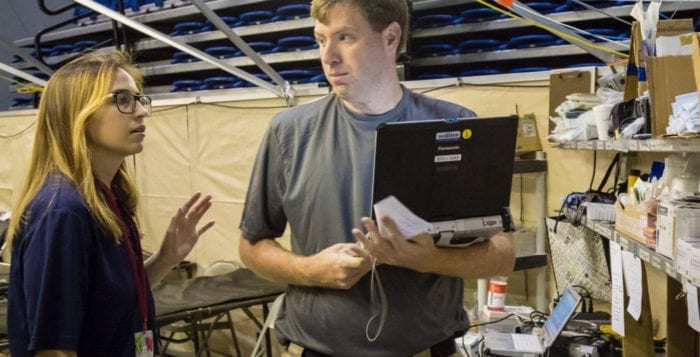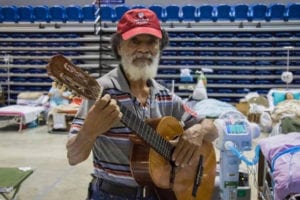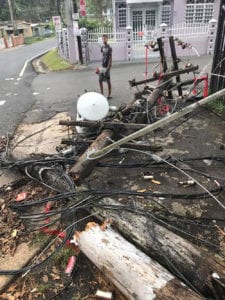Stony Brook Medicine eases the pain in Puerto Rico

Many in Puerto Rico still reeling from the devastation of Hurricane Maria recently received much-needed medical care from a local Long Island hospital.
There were 23 staff members from Stony Brook Medicine stationed on the island from Oct. 24 to Nov. 8 as part of a 78-member relief team consisting of professionals from New York metropolitan hospitals. Three physicians, two nurse practitioners, nine nurses, four paramedics, four nursing assistants and one pharmacist from Stony Brook put their skills to use to help those with physical aliments and relieve overloaded hospitals in Puerto Rico.
The Coliseo Juan Aubin Cruz Abreu “Bincito” in Manati, Puerto Rico, was the temporary workplace of 19 from Stony Brook, while four others assisted at Hospital HIMA San Pablo-Fajardo for a week, followed by another seven days on the U.S. Navy hospital ship USNS Comfort, which is docked in Old San Juan.
Dr. R. Trevor Marshall, emergency physician and director of Emergency Medical Services at Stony Brook, said he and 18 others worked with the Disaster Medical Assistance Teams — part of the National Disaster Medical System — Veterans Affairs and the U.S. Army at the coliseum in Manati.
“It was a nice way to be able to provide additional resources down there to help the local community,” he said.

The physician said the staff members treated patients with diarrhea, conjunctivitis, abscesses, severe cuts and broken bones. Marshall said the patients were appreciative, and the staff was grateful for local high school and college students who volunteered their time to translate. The South Setauket resident said it was his first medical relief trip, and he’s open to volunteering for another one in the future due to his positive experience in Puerto Rico.
“This was an outstanding opportunity,” Marshall said.
Dr. Richard Scriven, associate professor of surgery and pediatrics at Stony Brook University, was one of the doctors working alongside Marshall at the coliseum. While driving from the airport to the arena he said he could see half of the homes were covered with the tarps that the Federal Emergency Management Agency provided to protect the houses that lost roofs during the Category 5 hurricane.
He said the staff would alternate working 12-hour shifts, slept on cots in the mezzanine section and bathed in outdoor showers. Scriven said food was provided from the local veterans agency, nearby residents and appreciative patients who bought them pizzas.
The physicians said DMAT tents were set up outside the arena, where many patients were treated for minor ailments. Inside were 50 to 70 inpatients who were frail and on ventilators and mostly relocated from nursing homes.
Scriven, who lives in Stony Brook, said he and others would walk to the nearest Walgreens, and while Manati didn’t have as much damage as other areas, many were still without power and he didn’t witness any utility crews working on restoring it.
“Yet the people were so nice, so appreciative and really amazing,” Scriven said.

Emergency Medical Specialist Dr. Rolando Valenzuela, a St. James resident, was one of the team members who spent time in Fajardo and on the USNS Comfort. He said the hospital in Fajardo needed help with its emergency room, and the New York medical professionals assisted with ambulatory patients and mostly dealt with benign medical complaints. He said a number of people were in distress because they were unable to get treatment for diabetes or use medical equipment such as nebulizers and oxygen concentrators without electricity. Others were experiencing health problems as a result of a lack of water or medications.
Valenzuela said many hospitals on the island are low on supplies and are operating on generators. Any kind of extensive imaging or lab work wasn’t available on site; however, the staff had basic medications, antibiotics, IV fluids and EKG machines on hand.
“The medical infrastructure is ground down to a halt,” Valenzuela said.
Patients with more serious problems in Fajardo were transported to San Juan or to the USNS Comfort. The ship was staffed by Navy personnel and DMAT tents were set up outside for ambulatory patients. Valenzuela said medical professionals from around the country working in the tents saw 500 to 600 patients a day. Patients with serious conditions were transferred to the Comfort.
“I can’t say enough about how amazing the Navy personnel was,” Valenzuela said. “These guys had been on board for over a month before they were allowed off the ship. They were getting a few hours of sleep here and there but their main focus was on treating patients.”
Valenzuela visited Puerto Rico in the past and remembered how friendly the people were, and said despite the devastation on the island, the residents were in good spirits.
“The people were extremely enthusiastic to have us there,” he said. “They were so grateful for any kind of assistance. They just wanted to make sure that they weren’t being forgotten, and we did our best to provide them with the standard of care that would be acceptable on Long Island. I think we were successful.”






